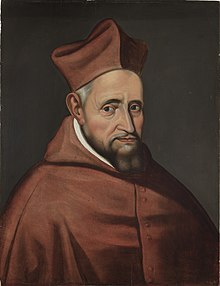
Back روبرت بيلارمن Arabic روبرت بيلارمن ARZ Роберто Белармино Bulgarian Roberto Bellarmino Catalan Robert Bellarmino Czech Bellarmino Danish Robert Bellarmin German Roberto Bellarmino Esperanto Roberto Belarmino Spanish Roberto Bellarmino Basque
Robert Bellarmine | |
|---|---|
| Cardinal, Archbishop Emeritus of Capua | |
 17th-century portrait of Robert Bellarmine, Antwerp, Museum Plantin-Moretus | |
| Church | Catholic Church |
| Archdiocese | Capua |
| Appointed | 18 March 1602 |
| Installed | 21 April 1602 |
| Term ended | August 1605 |
| Predecessor | Cesare Costa |
| Successor | Antonio Caetani Jr. |
| Other post(s) | Cardinal-Priest of Santa Prassede |
| Orders | |
| Ordination | 19 March 1570 |
| Consecration | 21 April 1602 by Clement VIII |
| Created cardinal | 3 March 1599 by Clement VIII |
| Rank | Cardinal-Priest |
| Personal details | |
| Born | 4 October 1542 |
| Died | 17 September 1621 (aged 78) Rome, Papal States |
| Coat of arms |  |
| Sainthood | |
| Feast day | 17 September; 13 May (General Roman Calendar, 1932–1969) |
| Venerated in | Catholic Church |
| Title as Saint | Confessor and Doctor of the Church |
| Beatified | 13 May 1923 Rome, Kingdom of Italy by Pius XI |
| Canonized | 29 June 1930 Rome, Vatican City by Pius XI |
| Patronage | Bellarmine University, Bellarmine Preparatory School, Fairfield University, Bellarmine College Preparatory, St. Robert's School, Darjeeling, canonists, canon lawyers, catechists, Robert Barron (bishop), catechumens, Archdiocese of Cincinnati, St. Robert Catholic High School |
| Shrines | Chiesa di Sant'Ignazio, Rome, Italy |
Robert Bellarmine SJ (Italian: Roberto Francesco Romolo Bellarmino; 4 October 1542 – 17 September 1621) was an Italian Jesuit and a cardinal of the Catholic Church. He was canonized a saint in 1930[1] and named Doctor of the Church, one of only 37. He was one of the most important figures in the Counter-Reformation.
Bellarmine was a professor of theology and later rector of the Roman College, and in 1602 became Archbishop of Capua. He supported the reform decrees of the Council of Trent. He is also widely remembered for his role in the Giordano Bruno affair,[2][3] the Galileo affair, and the trial of Friar Fulgenzio Manfredi.[4]
- ^ Jestice, Phyllis G. (2004). Holy People of the World: A Cross-cultural Encyclopedia. ABC-CLIO. p. 114. ISBN 978-1-57607-355-1. Archived from the original on 20 February 2023. Retrieved 19 November 2020.
- ^ Gibbings, Richard (1852). Were "heretics" Ever Burned Alive at Rome?: A Report of the Proceedings in the Roman Inquisition Against Fulgentio Manfredi. Taken from the Original Manuscript Brought from Italy by a French Officer, and Edited, with a Parallel English Version and Illustrative Additions. John Petheram. pp. 44–45. Archived from the original on 20 February 2023. Retrieved 19 November 2020.
- ^ Martinez, Alberto A. (1 October 2016). "Giordano Bruno and the heresy of many worlds". Annals of Science. 73 (4): 345–374. doi:10.1080/00033790.2016.1193627. ISSN 0003-3790. PMID 27607442. S2CID 25425481.
- ^ Perkins, William (1600). A Golden Chain or the description of Theology (PDF). University of Cambridge. p. 155. Archived (PDF) from the original on 9 October 2022.